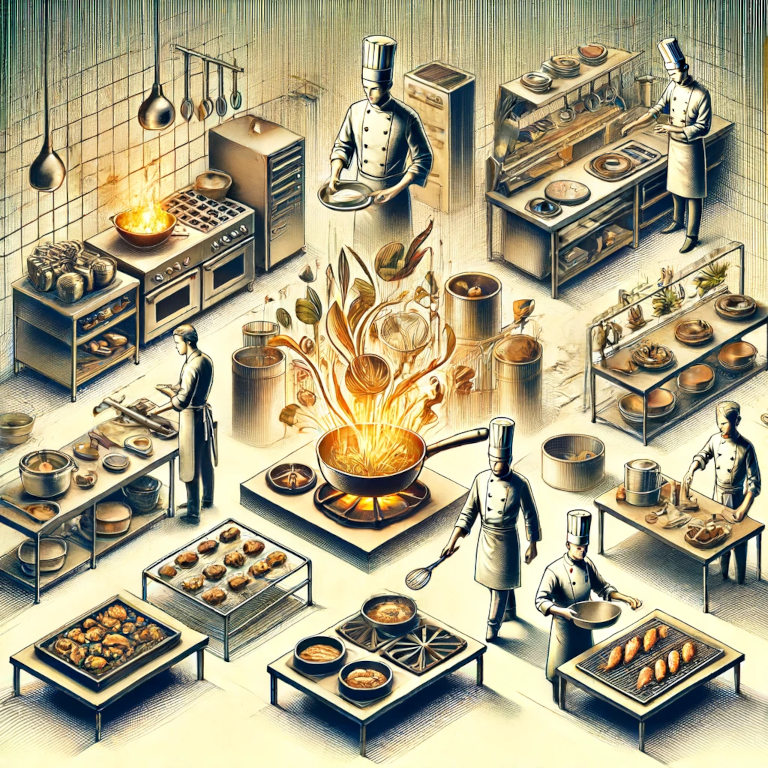Culinary techniques are the backbone of any great kitchen, shaping the way ingredients transform into dishes that delight and inspire. As an expert in Food and Cooking, understanding and mastering various cooking techniques can elevate a simple meal into a gastronomic experience. This article explores essential culinary techniques that every home chef and culinary enthusiast should know to enhance their cooking repertoire.
Essential Culinary Techniques
1. Sautéing: This technique involves cooking food quickly in a small amount of oil or fat over relatively high heat. The key is to keep the food moving, usually by tossing or flipping it in the pan, to ensure even cooking and prevent burning. Sautéing is ideal for cooking vegetables, small pieces of meat, or seafood, providing a deliciously browned exterior and a moist interior.
2. Braising: Braising is a combination cooking method that starts with searing at a high temperature and then finishes in a covered pot at a lower temperature while sitting in some amount of liquid. This technique is perfect for tougher cuts of meat and hearty vegetables, as the slow cooking process tenderizes the ingredients and enriches the flavors.
3. Roasting: Roasting involves cooking food in an oven using dry heat that envelops the food, cooking it evenly on all sides. This method is excellent for cooking large cuts of meat, whole poultry, and vegetables. The dry heat helps caramelize the natural sugars in foods, yielding a rich flavor and appealing color.
4. Grilling: Grilling uses dry heat applied from below or above to cook the food. It imparts a distinct charred flavor that is highly sought after, especially for meats and vegetables. Proper grilling techniques involve managing the heat to avoid burning while achieving a perfect external crust.
5. Steaming: This cooking method uses the steam from boiling water to cook food. Steaming is a gentle way to cook, making it ideal for delicate foods such as fish and vegetables. It preserves the natural flavors of the ingredients and offers significant health benefits by retaining nutrients.
6. Baking: Unlike roasting, baking is centered around items that lack structure early on, such as doughs and batters. Baking requires precise control of temperature and timing to achieve the desired texture and doneness.
Advanced Techniques for the Culinary Enthusiast
1. Sous Vide: This method involves vacuum-sealing food in a bag and cooking it to a very precise temperature in a water bath. This technique ensures maximum tenderness and moisture retention, ideal for gourmet dishes.
2. Fermentation: Fermentation is a culinary process where food is exposed to bacteria and yeasts, either naturally or through inoculation. Examples include making yogurt, cheese, and sauerkraut. This technique not only preserves the food but also enhances its flavors and health benefits.
3. Emulsifying: Emulsification is the process of combining two ingredients together which ordinarily do not mix, like oil and vinegar. Mastery over emulsification is crucial for making sauces and dressings.
Tips for Implementing These Techniques
- Practice Makes Perfect: Regular practice is essential to mastering these techniques. Start with simple recipes and gradually challenge yourself with more complex dishes.
- Quality Ingredients: High-quality ingredients can significantly enhance the outcome of your culinary efforts. Invest in fresh, local produce and high-grade proteins.
- Proper Tools: Having the right tools for the job can make a significant difference. Invest in a good set of knives, a variety of pans, and specialty appliances like a sous vide machine if you are advancing towards gourmet cooking.
Understanding and applying various culinary techniques can transform your cooking from ordinary to extraordinary. Whether you’re a home cook looking to refine your skills or a budding chef aspiring to greatness, mastering these techniques will enhance your culinary prowess and expand your ability to create outstanding dishes. Each technique, from sautéing to fermentation, offers unique advantages and flavors, providing endless possibilities for culinary creativity and exploration. Embrace these methods to not only improve your cooking but also to deepen your appreciation of the culinary arts.






